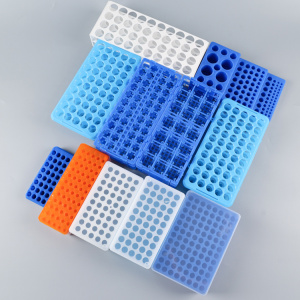What laboratory instruments and consumables are needed for the nucleic acid detection of the new coronavirus?
Many people are anxious to get the results after the nucleic acid test, thinking that the nucleic acid test is just throwing the collected samples into a large machine, and turning around a few times to get the results. In fact, the truth is far from that simple. Yongyue checked the description of the nucleic acid testing process and found that after the nucleic acid samples were delivered to the laboratory, they had to go through a series of procedures such as registration, sorting, sample addition, spotting, extraction, and amplification. The entire testing process took four to six hours. In the amplification program, once it is turned on, no new samples can be added, and the next amplification can only be started after one round of amplification is completed.
Multiple testing equipment that requires each person's equipment and equipment used in the laboratory, various equipment, very common, their number, various types of equipment, very common, their number and appearance inspection. Various tools needed in the laboratory.
First of all, in order to ensure the successful holding of each series, the selected category of samples, the selected samples, the description studio is to be divided, processed and distributed through carefully selected areas, and the preparation and distribution of product analysis areas; independent areas Completely in physical space, there can be no direct air circulation.
The laboratory instruments used in the three areas are described below:
(1) Reagent storage and preparation area: its function is to store the preparation of reagents, the sub-packaging of reagents and the preparation of amplification reaction mixture, as well as the storage and preparation of laboratory equipment consumables. The instruments used are:
1. Ultra-clean workbench: The ultra-clean workbench is also known as the purification workbench, which can protect the reagents operating in the workbench from contamination. The filter is filtered, and the filtered air is sent out in the state of vertical or horizontal airflow, so that the operating area can reach the cleanliness level of class 100 and ensure the requirements of production on the cleanliness of the environment.
2. Electronic balance: Electronic balance is a commonly used measuring instrument in the laboratory. In addition to weighing, it can also realize functions such as counting and density measurement. Nucleic acid testing laboratory electronic balances are mainly used for weighing samples, reagents and standards.
3. Pure water machine: used to prepare ultrapure water required for experiments.
4. Pipette set: A pipette, also called a pipette gun, is a measuring tool that transfers the liquid from the original container to another container within a certain range. Widely used in clinical diagnostic laboratories, biotechnology laboratories, pharmacy and chemical laboratories, etc.
5. Small centrifuge: A centrifuge is an instrument that uses centrifugal force to separate liquid and solid particles, or to separate components in a mixture of liquid and liquid. Commonly used low-speed centrifuges have a rotation speed of 0-5000r/min, and a high rotation speed can reach more than 10000r/min.

6. Vortex mixer (mixer): The mixer is a commonly used instrument in the laboratory for sample incubation, catalysis, mixing and other operations. There are a variety of models and specifications to choose from.
7. Refrigerator: used for temporary reagent storage, it is required to meet the two storage requirements of -20°C & 4°C.
8. Mobile UV lamp: used for UV disinfection of rooms and external surfaces of equipment.
(2) Sample processing area: The main functions are the opening of the transfer barrel, the inactivation of the sample (if applicable), the extraction of nucleic acid and its addition to the amplification reaction tube, etc. The instruments used are:
1. Biological safety cabinet: The biological safety cabinet is the most basic safety protection equipment in the primary protective barrier of biomedical experiments. It is a box-type air purification negative pressure safety device, which can prevent some dangerous or unknown during the experimental operation Aerosol emission of biological particles occurs. The difference between a biological safety cabinet and an ultra-clean workbench is that the ultra-clean workbench only protects the operating samples from contamination, while the biological safety cabinet can protect both the operating samples and the operators.
2. Pipette: used to pipette the reagents required for various tests.
3. Small centrifuge: used to separate samples or reagents.
4. High-speed centrifuge: a centrifuge with a speed of more than 10,000 r/min, used for centrifugation of reagents.
5. Vortex mixer: It is used to shake and mix the reagents, and it is the pretreatment equipment for nucleic acid detection.
6. Water bath: The water bath is an instrument used for water bath heating. The constant temperature water bath can control the heating temperature and can be used for evaporation, drying, concentration, and constant temperature heating. The nucleic acid laboratory water bath is mainly used for sample pretreatment.
7. Mobile UV lamp: used for disinfection of laboratory environment and equipment.
8. Refrigerator: Storage of samples and reagents, etc.



